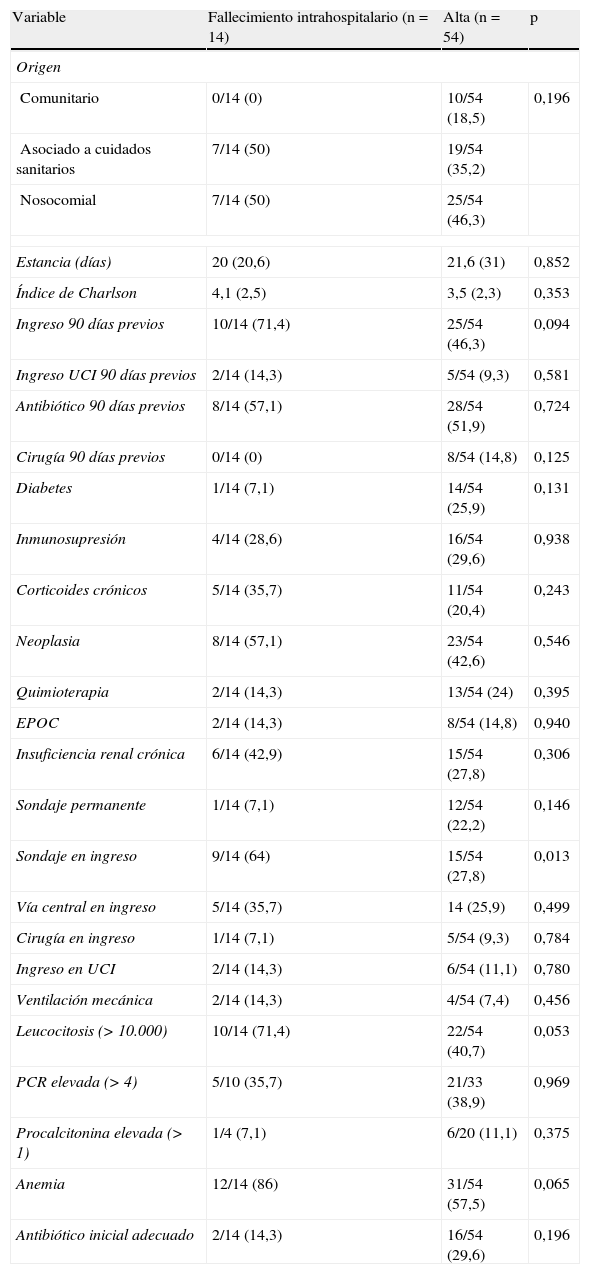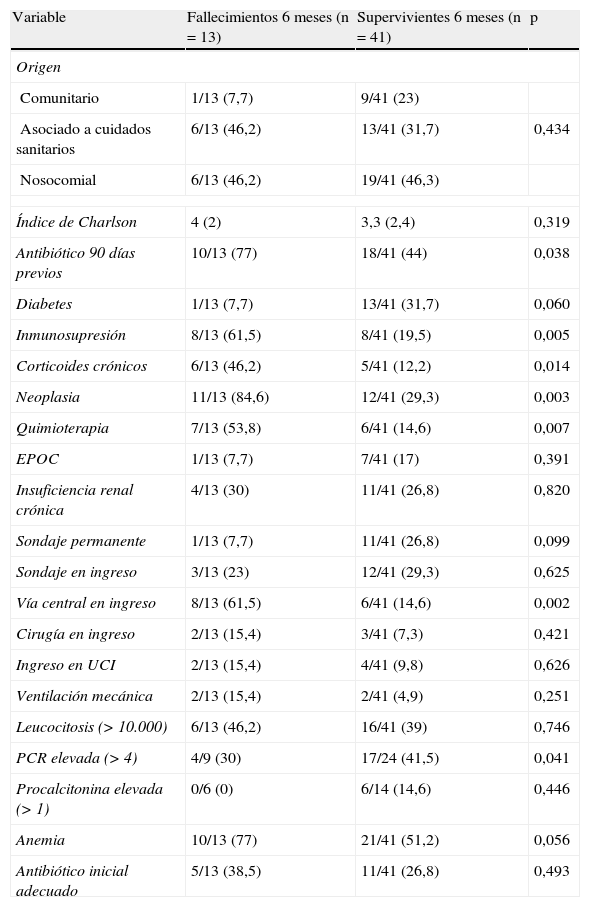Las bacteriemias causadas por bacterias productoras de betalactamasas de espectro extendido (BLEE) han aumentado de forma exponencial. Nuestro objetivo es conocer los factores asociados a la mortalidad y el reingreso en estos pacientes.
Pacientes y métodosSe recogieron datos socioepidemiológicos, clínicos y analíticos (desde 1-01-2008 hasta 31-04-2011). Se clasificaron en nosocomiales, asociadas a cuidados sanitarios o comunitarias. Se realizó un estudio descriptivo analizando las diferencias según la bacteria responsable y las variables asociadas a mortalidad y reingreso. Se utilizaron: t de Student, ANOVA de un factor, χ2 y prueba exacta de Fisher para comparar variables. Se realizó un análisis de regresión logística para identificar variables asociadas de forma independiente a mortalidad y reingreso. Se utilizó el programa estadístico SPSS® v18.
ResultadosSe identificaron 68 pacientes. El 73,5% de las infecciones fueron causadas por Escherichia coli (E. coli) y el 26,5% por Klebsiella pneumoniae (K. pneumoniae). El origen nosocomial, la identificación en pacientes críticos y el origen abdominal fueron más frecuentes para K. pneumoniae, siendo el foco urinario más frecuente para E. coli. La mortalidad intrahospitalaria fue del 20,6% (24% durante el seguimiento). El principal factor asociado a mortalidad intrahospitalaria fue el tratamiento antibiótico previo (OR 8,37; IC 95%: 1.094-64.091), y a la mortalidad durante el seguimiento, la canalización de una vía venosa central (OR 8.416; IC 95%: 1.367-51.821). El 55,5% de los pacientes precisaron reingreso; las variables asociadas fueron el origen nosocomial (OR 4.801; IC 95%: 1.057-21.802) y el tratamiento antibiótico previo (OR 4.715; IC 95%: 1.125-19.766). El tratamiento antibiótico empírico inadecuado no se relacionó con mayor mortalidad o reingreso.
ConclusionesLa bacteriemia por E. coli y K. pneumoniae productoras de BLEE conlleva una alta mortalidad y probabilidad de reingreso. El tratamiento antibiótico previo es el principal factor asociado a una mala evolución.
The incidence of bloodstream-infections caused by extended-spectrum betalactamases (ESBL)-producing bacteria has increased exponentially. The objective of this study is to determine the factors related to mortality and readmission in these patients.
Patients and methodsSocio-epidemiological, clinical and laboratory data has been collected (from January, 1st 2008 to April, 31th 2011). They were classified as nosocomial, healthcare-associated or community-acquired data. A descriptive research was conducted to determine the main differences in terms of responsible bacteria and variables associated with mortality and readmission rates. The following techniques were used to compare variables: Student's t-test, one-way ANOVA test, χ2-test and Fisher's exact test. A logistic-regression analysis was performed to identify variables independently related to mortality and readmission, using SPSS® statistics software v18.
ResultsA total of 68 patients were included in the study: 73.5% of the infections were caused by Escherichia coli (E. coli), and 26.5% by Klebsiella pneumoniae (K. pneumoniae). Nosocomial origin, critical condition of patients, and abdominal location were more frequent when K. pneumoniae was isolated; urinary tract was the most frequent site of E. coli infections. The in-hospital mortality reached 20.6%, and 24% during the follow-up period. The main factor associated to in-hospital mortality was previous antibiotic treatment (OR 8.37; CI 95%: 1.094-64.091); within the follow-up period, the first mortality factor was central venous catheterization (OR 8.416; CI 95%: 1.367-51.821). Readmission was required in 55.5% of patients. The main variables associated were nosocomial origin (OR 4.801; CI 95%: 1.057-21.802) and previous antibiotic treatment (OR 4.715; CI 95%: 1.125-19.766). Inadequate antibiotic treatment was not associated with increased mortality or readmission.
Conclusions ESBL-producing E. coli and K. pneumoniae bloodstream-infections are linked to a high mortality and readmission risk. Previous antibiotic treatment is the main factor associated to a poor outcome.
Artículo
Comprando el artículo el PDF del mismo podrá ser descargado
Precio 19,34 €
Comprar ahora









